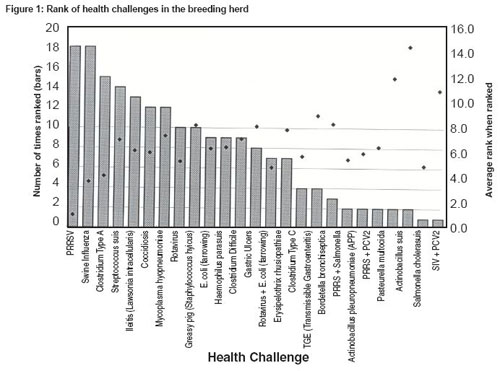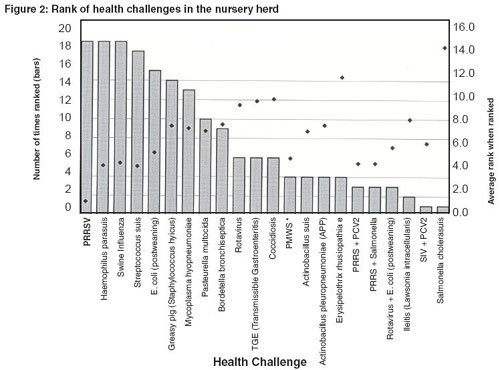



Economic Cost of Major Health Challenges in Large US Swine Production Systems—Part 1
By Derald Holtkamp, DVM, Iowa State University; Hans Rotto, DVM, Innovative Agriculture Solutions and Roberto Garcia, DVM, Merial Ltd.
Introduction
Estimates of the economic impact of specific diseases on the U.S. swine industry are available for very few diseases. Recent research estimated the annual cost of PRRS in the U.S. to be approximately $560 million.1 However, more comprehensive estimates of the impact of all major health challenges have not been published. A comprehensive estimate of all major swine health challenges is needed to facilitate industry benchmarking and to help guide animal health related investments in the industry. The objective of this study was to rank and quantify productivity and economic losses in the swine industry due to the major health challenges. Information on production and economic impacts was obtained through use of face-to-face, personal interviews. The focus of the study was on the segment of the U.S. industry producing more than 150,000 pigs per year. This segment currently markets just under half of the pigs sold annually in the U.S.
Materials and methods
The companies producing more than 150,000 pigs per year were identified. This population of companies was further segmented by size, vertical integration, and geographic location in order to assure representation of the entire population of interest. Production companies with 7,500 to 25,000 sows were considered “medium” sized while companies with more than 25,000 sows were considered “large.” Vertically integrated companies for the purposes of this project were defined as those that have integrated live animal production, slaughter, and processing. Only companies with more than 25,000 sows were segmented as integrated or not integrated since very few producers with fewer than 25,000 sows are vertically integrated. The U.S. was divided into three geographic regions based upon USDA’s 10-region classification. The groups are East (Appalachian, Delta, Northeast, Southeast), Midwest (Cornbelt, Lake States), and West (Northern Plains, Pacific Northwest, Southern Plains, Mountain). This segmentation scheme resulted in nine segments (Table 1). Two production companies from each of the nine segments were selected for inclusion in the study. A third medium-sized company in the West was surveyed for a total of 19 surveys. When production companies had major operations in more than one geographic location, each location was considered a separate entity. Selection of companies was based on the anticipated willingness to participate and availability of interviewees during the timeline of the project and, therefore, not random. Only one company asked to participate declined.

A survey was developed and administered to a single veterinarian at each company through faceto- face, personal interviews. The same interviewer administered all of the surveys in a consistent manner to minimize any differences in the results attributable to differences in how the surveys were administered. All of the surveys were conducted between November of 2005 and February of 2006.
Results
The relative rankings for each of the health challenges are reported here. The ranking of health challenges according to the productivity losses attributed to each in the breeding, nursery, and finishing herds are reported in Figures 1, 2 and 3.

Clostridial diseases as a group were identified as the next most significant health challenge in the breeding herd. Clostridium perfringens type A was ranked as a health challenge in 15 of the 19 companies with an average rank of 4.1, Clostridium difficille ranked in 9 of the 19 companies with average rank of 7.1, and Clostridium perfringens type C ranked in 4 of 19 companies with average rank of 5.8. Rotavirus alone or in combination with E. coli was cited as a breeding herd health challenge for 15 of the 19 companies. As a single pathogen it was cited as a health challenge in 10 companies with an average rank of 5.3. In combination with E. coli, rotavirus was cited as a health challenge for 7 companies with an average rank of 4.9, higher than that of rotavirus alone. Streptococcus suis and Coccidia were cited as a health challenge for 14 and 12 companies with an average rank of 7.0 and 6.0, respectively. Ileitis and Mycoplasma hyopneumoniae were ranked for 13 and 12 companies with an average rank of 6.2 and 7.3, respectively. The last three on the list of health challenges in the breeding herd cited for more than half the companies were greasy pig disease, E. coli, and Haemophilus parasuis.
Nursery herd
In the nursery herd, PRRSV was the most frequently ranked health challenge (Figure 2). As in the breeding herd, it was ranked as a health challenge in 18 of the 19 companies surveyed and was ranked as the number one health challenge in all but one of the 18 companies in which it ranked. PRRSV was also ranked as a major health challenge in combination with Salmonella and PCV2 for 2 companies. Haemophilus parasuis and swine influenza were also ranked as a health challenge for 18 of the 19 companies with an average rank of 4.1 and 4.3. Swine influenza also ranked as health challenge in combination with PCV2 for one company. Streptococcus suis was cited as a health challenge for 17 of 19 companies with an average rank of 4.1. E. coli was ranked for 15 companies with an average rank of 5.2. Greasy pig, Mycoplasma hyopneumoniae, Pastuerella multocida, and Bordatella bronchiseptica complete the list of health challenges cited for more than half the companies. PMW, PRRS in combination with PCV2, and SIV in combination with PCV2 were all cited as nursery problems in a small percentage of the companies surveyed, but when cited, the productivity losses associated with them were ranked relatively high. At the time the surveys were completed, Porcine Circovirus Associated Diseases (PCVAD) had not yet been adopted.

April 2007








